granite
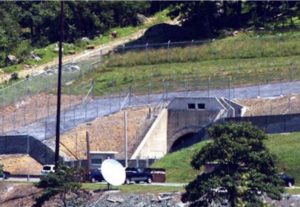 Known as Site R, Raven Rock Mountain Complex is a deep underground facility approved for construction by President Harry S Truman in 1950. The plan was for it to be a relocation site for the Pentagon in times of national emergency. To build the site, they workers had to blast out one half a million cubic yards of greenstone granite rock. The super-hard granite was secretly blasted out and hauled away over a period of ten months, to build five separate three-story buildings deep inside the mountain located along the border between Pennsylvania and Maryland, in Adams County, Pennsylvania. It operates under a number of…almost code names, Site R, AJCC: Alternate Joint Communications Center, ANMCC: Alternate National Military Command Center, NMCC-R: National Military Command Center – Raven Rock, USAG-RR: U.S. Army Garrison – Raven Rock, the Underground Pentagon, the Little Pentagon, the Backup Pentagon, the Rock, and for the old-timers: Harry’s Hole. All are interesting nicknames, for sure.
Known as Site R, Raven Rock Mountain Complex is a deep underground facility approved for construction by President Harry S Truman in 1950. The plan was for it to be a relocation site for the Pentagon in times of national emergency. To build the site, they workers had to blast out one half a million cubic yards of greenstone granite rock. The super-hard granite was secretly blasted out and hauled away over a period of ten months, to build five separate three-story buildings deep inside the mountain located along the border between Pennsylvania and Maryland, in Adams County, Pennsylvania. It operates under a number of…almost code names, Site R, AJCC: Alternate Joint Communications Center, ANMCC: Alternate National Military Command Center, NMCC-R: National Military Command Center – Raven Rock, USAG-RR: U.S. Army Garrison – Raven Rock, the Underground Pentagon, the Little Pentagon, the Backup Pentagon, the Rock, and for the old-timers: Harry’s Hole. All are interesting nicknames, for sure.
Once you are inside, you would not really know that you are underground, because, other than no outside 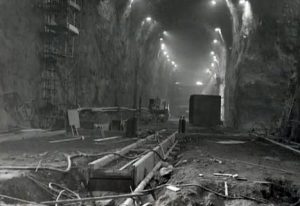 windows, the buildings look like any other office building. The underground complex has roads and perking areas that are big enough to accommodate trucks and buses. The facility is completely self-sufficient, boasting two power plants for electricity, multiple underground water reservoirs and a highly sophisticated ventilation system. It also has a medical and dental clinic, fire department, post office, dining facility, snack bar, dormitories, chapel, barbershop, fitness center, bowling alley, and even a Starbucks. It can accommodate 3,000 people in the event of an emergency, and can operate for at least 30 days in a “buttoned-up” position. Basically the facility is a small city.
windows, the buildings look like any other office building. The underground complex has roads and perking areas that are big enough to accommodate trucks and buses. The facility is completely self-sufficient, boasting two power plants for electricity, multiple underground water reservoirs and a highly sophisticated ventilation system. It also has a medical and dental clinic, fire department, post office, dining facility, snack bar, dormitories, chapel, barbershop, fitness center, bowling alley, and even a Starbucks. It can accommodate 3,000 people in the event of an emergency, and can operate for at least 30 days in a “buttoned-up” position. Basically the facility is a small city.
In the event of a war situation, the United States must be able to have a Continuity of Operations Plan (COOP) for the Office of the Secretary of Defense and the Joint Staff…basically a blueprint for how the government would re-position itself, if a major catastrophe strikes. Should the country find itself in such peril Senior leaders would be flown in by helicopter from the Pentagon and DOD emergency relocation teams all participate in real-life scenarios which test the alert and notification procedures along with the reception, staging, onward  movement, and integration (RSOI) procedures. These include the COOP transportation plans, Site R hasty access procedures, and the integration of mission essential functions within the operating routine of the alternate site, the backup Pentagon. Defense communications and planning would allegedly be handled at the Raven Rock Mountain Complex, but the structure of such a strategy has been hotly debated. Some sites on the internet had posted a “virtual tour” of Site R, but it is not the real site, other than possibly the pictures of the original work being done. Sites like this, that have national security as their top priority, are not something that is usually open to the public for viewing.
movement, and integration (RSOI) procedures. These include the COOP transportation plans, Site R hasty access procedures, and the integration of mission essential functions within the operating routine of the alternate site, the backup Pentagon. Defense communications and planning would allegedly be handled at the Raven Rock Mountain Complex, but the structure of such a strategy has been hotly debated. Some sites on the internet had posted a “virtual tour” of Site R, but it is not the real site, other than possibly the pictures of the original work being done. Sites like this, that have national security as their top priority, are not something that is usually open to the public for viewing.

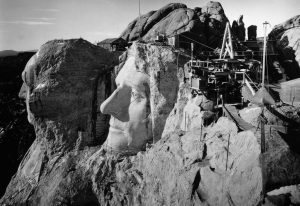 When a construction project begins, it usually takes a matter of a few months to complete. That is not how it works when carving a large sculpture, such as Mount Rushmore. Mount Rushmore National Memorial is a sculpture carved into the granite face of Mount Rushmore, a batholith in the Black Hills in Keystone, South Dakota, United States. It was the vision of Doane Robinson, who thought that carving the faces of famous people in the Granite of the Black Hills region, would bring tourists to the region. Robinson’s vision has proven to be an amazing success. His original idea was to put the sculpture in the area of the Needles, but the chosen sculptor, Gutzon Borglum rejected the idea because of the poor quality of the granite, and strong opposition from the Native American Groups in the area. I’m glad it didn’t go in the needles area, because they have a beauty all their own, and it would have been a shame to change them.
When a construction project begins, it usually takes a matter of a few months to complete. That is not how it works when carving a large sculpture, such as Mount Rushmore. Mount Rushmore National Memorial is a sculpture carved into the granite face of Mount Rushmore, a batholith in the Black Hills in Keystone, South Dakota, United States. It was the vision of Doane Robinson, who thought that carving the faces of famous people in the Granite of the Black Hills region, would bring tourists to the region. Robinson’s vision has proven to be an amazing success. His original idea was to put the sculpture in the area of the Needles, but the chosen sculptor, Gutzon Borglum rejected the idea because of the poor quality of the granite, and strong opposition from the Native American Groups in the area. I’m glad it didn’t go in the needles area, because they have a beauty all their own, and it would have been a shame to change them.
They settled on Mount Rushmore, which also has the advantage of facing southeast for maximum sun exposure, which makes the faces of our presidents stand out in an amazing way. Robinson wanted it to feature American West heroes like Lewis and Clark, Red Cloud, and Buffalo Bill Cody, but Borglum decided the sculpture should have broader appeal and chose the four presidents. Borglum created the sculpture’s design and oversaw the project’s execution from 1927 to 1941 with the help of his son, Lincoln Borglum. When I think of the years it too to complete the sculpture, I wonder if it was what was expected, or just the way it came down. Mount Rushmore features 60-foot sculptures of the heads of four United States presidents…George Washington (1732–1799), Thomas Jefferson (1743–1826), Theodore Roosevelt (1858–1919), and Abraham Lincoln (1809–1865). After securing federal funding through the enthusiastic sponsorship of “Mount Rushmore’s great political patron” US Senator Peter Norbeck, construction on the memorial began in 1927, and the presidents’ faces were completed between 1934 and 1939. Upon Gutzon Borglum’s death in March 1941, his son Lincoln Borglum took over as leader of the construction project. Each president was originally to be depicted from head to waist.
The memorial park covers 1,278.45 acres and is 5,725 feet above sea level, and while the sculpture work officially ended on October 31, 1941, due to lack of funding and the very real possibility of a United States entrance into World War II. Mount Rushmore has become an iconic symbol of the United States, and it has 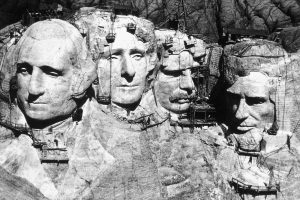
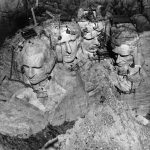 appeared in works of fiction, as well as being discussed or depicted in other popular works. It has also been featured a number of movies. It attracts over two million visitors annually. It’s amazing to me that what started out to be a tourist attraction, quickly became a must see place for every patriotic American. My husband and I love to go to the Black Hills, and with the close proximity to our Casper, Wyoming home, we take a week every summer to go and enjoy the beauty and patriotism that now resides there.
appeared in works of fiction, as well as being discussed or depicted in other popular works. It has also been featured a number of movies. It attracts over two million visitors annually. It’s amazing to me that what started out to be a tourist attraction, quickly became a must see place for every patriotic American. My husband and I love to go to the Black Hills, and with the close proximity to our Casper, Wyoming home, we take a week every summer to go and enjoy the beauty and patriotism that now resides there.
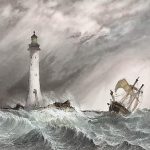
 As lighthouses go, Eddystone lighthouse is really quite different than most. The first Eddystone lighthouse was completed in 1699, and was the world’s first open ocean lighthouse, although the Cordouan lighthouse preceded it as the first offshore lighthouse. The Eddystone Lighthouse is on the dangerous Eddystone Rocks, 9 statute miles south of Rame Head, England, United Kingdom. While Rame Head is in Cornwall, the rocks are in Devon. Putting a lighthouse in the open ocean was a rather dangerous undertaking, but it was also an important lighthouse, because of the rocks it sat on. Without a lighthouse there, ships would run aground on the rocks.
As lighthouses go, Eddystone lighthouse is really quite different than most. The first Eddystone lighthouse was completed in 1699, and was the world’s first open ocean lighthouse, although the Cordouan lighthouse preceded it as the first offshore lighthouse. The Eddystone Lighthouse is on the dangerous Eddystone Rocks, 9 statute miles south of Rame Head, England, United Kingdom. While Rame Head is in Cornwall, the rocks are in Devon. Putting a lighthouse in the open ocean was a rather dangerous undertaking, but it was also an important lighthouse, because of the rocks it sat on. Without a lighthouse there, ships would run aground on the rocks.
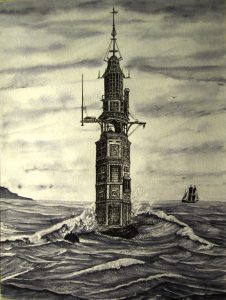
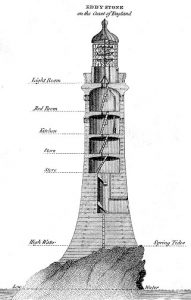
The Eddystone lighthouse fell to disaster three times, and was rebuilt threes times. The first disaster came just four years later, when the Great Storm of 1703 took with it, the first Eddystone lighthouse. The first and second lighthouses were constructed of wood. This was the material available at the time. It was also the wooden construction that made the lighthouse susceptible to the distructive storm and the fire that destroyed the first and second lighthouses…the storm in 1703 and the fire in 1755. The third lighthouse is often called Smeaton’s lighthouse. It was recommended by the Royal Society, civil engineer John Smeaton and was modeled in the shape on an oak tree, and built of granite blocks. He pioneered hydraulic lime, a concrete that cured under water, and developed a technique of securing the granite blocks using dovetail joints and marble dowels. Construction started in 1756 at Millbay and the light was first lit on October 16, 1759. It was state of the art in 
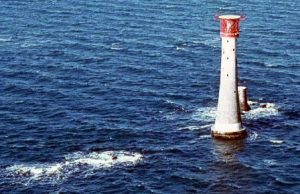 its time. It stood until 1877, when the rocks eroded enough to cause the lighthouse to rock from side to side in the waves, so it was deemed unsafe. The fourth and current lighthouse was built in April of 1879, and was designed by James Douglass, using Robert Stevenson’s developments of Smeaton’s techniques. By April 1879 the new site, on the South Rock was being prepared during the 3½ hours between ebb and flood tide. This current lighthouse is shorter and has a flat top, that is used to land helicopters.
its time. It stood until 1877, when the rocks eroded enough to cause the lighthouse to rock from side to side in the waves, so it was deemed unsafe. The fourth and current lighthouse was built in April of 1879, and was designed by James Douglass, using Robert Stevenson’s developments of Smeaton’s techniques. By April 1879 the new site, on the South Rock was being prepared during the 3½ hours between ebb and flood tide. This current lighthouse is shorter and has a flat top, that is used to land helicopters.

